Need an e-signature software solution for your business?
Depending on your needs, that might be easier said than done.
The modern e-signature market is competitive, and buyers are spoiled for choice.
In fact, there are so many e-signature tools out there that you might have trouble telling them apart!
Additionally, while some platforms only offer electronic signature solutions, several companies have expanded their product offering to include a variety of other features (storage, PDF editing, document creation, etc.).
This article digs into the details so that you can determine which e-signature tool is best for your business.
Comparing the best e-signature software
The best e-signing tool for your business will vary, depending on your use case and the gap you intend to fill.
This chart covers the most popular digital signing options available today. We’ll cover each one in depth below.
| Solution | Pricing | Key feature |
|---|---|---|
| PandaDoc | from $19/month | Full-scope document creation and unlimited e-signing. |
| DocuSign | from $15/month | Industry leader. Features robust security and niche integration options. |
| SignNow | from $20/month | Core e-signing features at budget-friendly price points. |
| SignEasy | from $15/month | Simple interface. Uncomplicated e-signing solution. |
| Adobe Acrobat Sign | from $23/month | Unmatched PDF editing and manipulation tools. |
| Dropbox Sign | from $20/month | Unlimited e-signing. Some plans include Dropbox storage options. |
| Xodo sign | from $13/month | Plans include SMS delivery options and multi-seat options. |
| SignRequest | from $10/month | Pro-level features at entry-level costs. Aimed at European brands. |
| Foxit eSign | from $8/month | Cost effective with a focus on bulk sending options. |
| Sharefile Premium | from $82.50/month | Onboard file storage. Customizable e-signing workflows. |
| DocSend | from $15/month | Advanced file sharing, organization, and virtual deal rooms. |
| GetAccept | from $25/month | Sales enablement focus. Features deal tracking, video presentation and live chat tools. |
| Proposify | from $50/month | Advanced proposal designer and content management platform. |
| OneSpan Sign | from $20/month | Advanced security and white labeling features. |
01. PandaDoc
PandaDoc is a robust document creation and automation platform that combines e-signatures, document creation, payment processing, and workflow management.
This platform is a great fit for businesses in need of a comprehensive solution for business documents like proposals, contracts, and invoices.
| Pros | Cons |
|---|---|
| + Onboard document creation. | – Might be too feature-rich for some users. |
| + Full document lifecycle management. | – Steeper learning curve compared to simpler e-signing solutions. |
| + Strong integration options. | |
As an e-signing platform, PandaDoc is unique in that it offers a document editor and tools to help users handle every aspect of the document process.
With PandaDoc, it’s possible to start from a blank page, build a document entirely from scratch, prepare it for e-signing, and send it to intended signers.
Savvy teams will also be able to optimize workflows and customize documents using advanced content and template management tools.
Done correctly, PandaDoc enables users to create personalized proposals in a matter of minutes while staying compliant with company branding and design guidelines.
Document editing & automation
The PandaDoc document editor closely resembles a word processor or a drag-and-drop style website builder.
Users can add text boxes, headings, and pricing tables, and other modules onto a blank page in order to create custom, stylized, and on-brand quotes, proposals, and contracts.
This no-code solution allows users to consolidate their entire document workflow into a single platform, eliminating the need to hop between word processors, e-signing tools, payment modules, and other single-service providers.
On top of that, documents can be managed on a modular level using the onboard content library.
This tool makes it possible to save documents, content blocks, layouts, and text snippets for reuse when creating future documents.
With PandaDoc, building reusable documents is simple, fast, and easy.
Paired with integrations to CRMs like Salesforce, HubSpot, Zoho, and others, it’s possible to marry your document creation process and customer data into a single, unified process.
More than simple e-signing
If you’re only looking for an electronic signature platform, the advanced features PandaDoc provides might be too much.
It’s possible to use PandaDoc like many other e-signature solutions by uploading documents and using the onboard drag-and-drop tools to facilitate the signing process.
Similar to competitors, PandaDoc provides a clear audit trail and a cloud-based storage solution for all your signed documents.
You’ll find custom branding options and storage integrations (Google Drive, Box, Dropbox, etc.) to facilitate quick uploads and reduce hassles.
However, if a simple e-signing solution is all you need, another e-signing platform — or the PandaDoc free plan — might be a better fit.
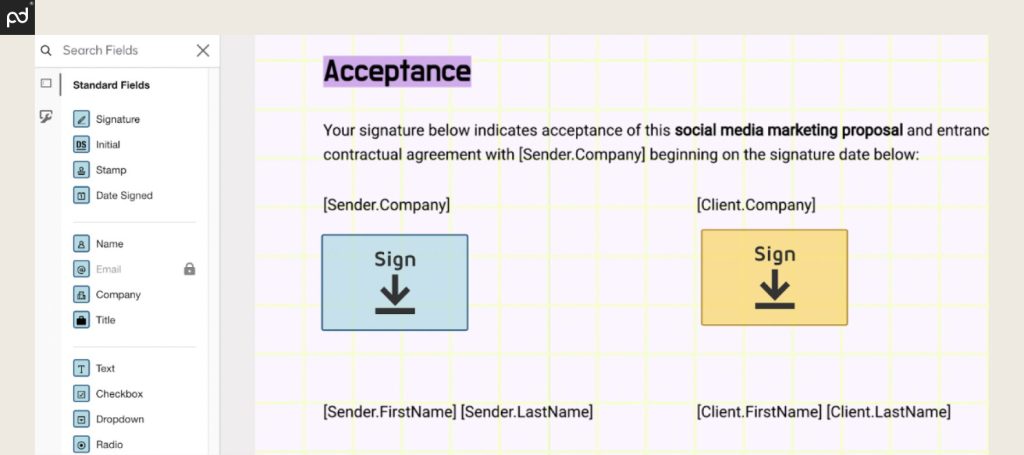
02. DocuSign
DocuSign is an industry-leading e-signature platform focused on security, reliability, and compliance.
This platform is a great fit for businesses across various sectors, especially those operating in highly regulated environments.
| Pros | Cons |
|---|---|
| + Industry standard. | – High costs. |
| + Simple & easy to use. | – Limited in scope. |
| + Most diverse integrations available. | – Transaction limits cap can incur extra fees. |
As an e-signature platform, DocuSign offers a unique emphasis on robust security features.
The platform offers tamper-evident audit trails (also available inside PandaDoc) and a strict adherence to modern e-signing protocols and regulations.
With DocuSign, users primarily work with pre-created documents — documents built using a third-party software tool — by uploading them into the system to prepare them for e-signing.
This streamlines the platform’s use case, narrowing its focus to important documents like contracts that require an electronic signature.
Savvy teams can utilize templates, customize signature workflows, and leverage a vast array of integrations to streamline their document process.
Done correctly, DocuSign enables users to facilitate rapid signature collection, ensuring the legality and enforceability of agreements across a wide variety of industries.
Security & compliance
While not as robust as OneSpan Sign (below), DocuSign prioritizes a secure e-signing experience.
The company employs encryption, various authentication options, timestamps, and detailed logs surrounding signature requests to ensure that the signing process is valid.
Like many apps used in electronic contract signing, the platform meets stringent security standards (eIDAS, UETA, ESIGN Act, etc.), and enterprise plans offer compliance solutions for even stricter standards such as HIPAA, FedRAMP, and 21 CFR part 11.
Additionally, the platform’s extensive integrations with popular CRMs, cloud storage, and productivity tools ensure seamless document workflows within existing systems.
Transaction limits & usage caps
Although powerful, DocuSign is stymied in part by its own restrictions and usage caps.
These limitations reduce the number of documents you can send for signing, and overage will incur additional expenses on top of the platform’s already-high costs.
On most plans, DocuSign sets limits of 100 envelopes per user/year, and a maximum of 10 envelopes per month.
The free and lower-tier personal plan have even lower limits.
The platform considers an “envelope” to refer to a single dispatch from the platform.
This could be a bundle of files prepared and sent to multiple users or a single contract sent to a single user, depending on how you configure your digital documents.
For teams who need to send a high volume of documents, DocuSign’s transaction limits can increase plan costs considerably.
To avoid this, consider limit-free alternatives to DocuSign like PandaDoc or Dropbox Sign.
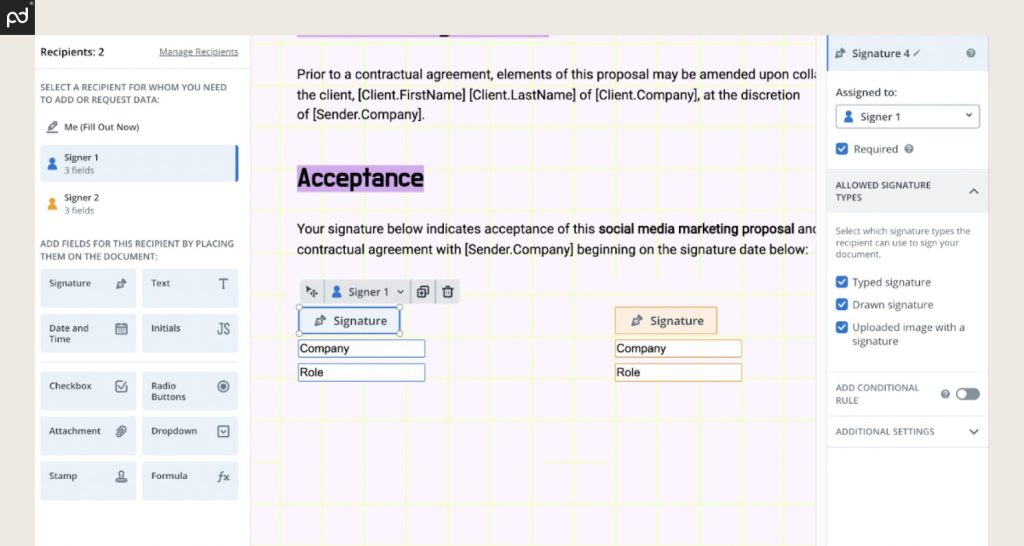
03. signNow
Part of the airSlate family, signNow is a streamlined e-signature platform designed around creating a fast, user-friendly approach to document signing.
This solution is a great fit for individuals and businesses that need a simple, cost-effective app to sign documents and who aren’t looking for the extra bells and whistles offered by other digital signature software solutions.
| Pros | Cons |
|---|---|
| + Affordable pricing. | – No document editing options. |
| + In-person signing on all plans. | – Limited advanced features. |
| + Just the basics. | – Integrations locked behind API plans. |
With signNow, users can upload existing documents (Word, PDFs, etc) and easily prepare them for digital signature.
The interface is focused around ease of use and is very approachable, even for less tech-savvy users.
With this streamlining, teams will still be able to leverage basic templates, configure signing roles, and create signing workflows to facilitate a consistent and hassle-free user experience.
Focused on ease of use
As a platform, signNow offers an affordable signing solution focused primarily on ease of use.
This solution is one of the most straightforward options on the market, both for users who need to send documents and for the signers who receive them.
Overall,signNow largely avoids complicated features or length setup processes, ensuring that documents are signed quickly and can be finalized with ease.
However, signNow isn’t just a barebones signing solution.
The mobile app is particularly well-designed, and advanced features like payment collection and conditional logic are still available on higher-end plans.
Similar to other competitors, signNow also offers audit trails, secure storage, and basic branding options.
Lacking advanced features
Although affordable and easy to use, this signNow lacks some of the advanced features that you might see in other platforms.
You won’t find a built-in document editor within signNow.
Similar to DocuSign, you’ll need to use a separate word processor or PDF editor — like pdfFiller, another airSlate product — to prepare your documents before uploading them for e-signing.
Additionally, signNow caps usage limits to 100 invites per user/year and reserves higher-end security features for its enterprise-level plans.
If your business relies on complex document workflows, strict regulatory compliance, custom white-labeling, or high-volume sending, signNow might not be the most suitable fit.
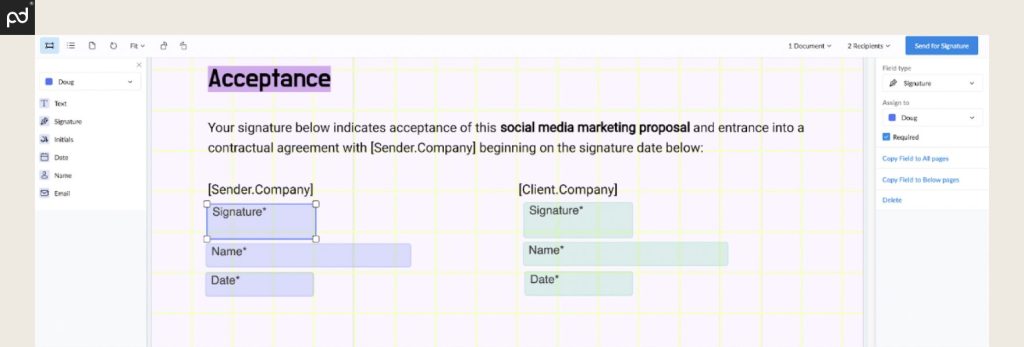
04. SignEasy
As an e-signing tool, SignEasy combines digital signatures and limited document management into a streamlined user experience.
This platform is ideal for individuals prioritizing quick turnaround times and routine document signing who aren’t necessarily looking for an abundance of complex features.
| Pros | Cons |
|---|---|
| + User-friendly interface. | – Many basic features locked behind higher-end plans. |
| + Emphasis on mobile signing. | – Limited integration options. |
| + Offline signing features. |
As with many other tools on our list, the SignEasy experience is largely restricted to the document signing process.
You’ll need to finalize documents in a word processor or PDF editor before uploading to SignEasy and using its drag-and-drop toolkit to add signature fields and other form elements.
This is standard fare for many alternatives to DocuSign — particularly tools that list digital signature capture as their core product offering.
Signing simplified
Of all the e-signing solutions available on the market today, SignEasy offers one of the simplest experiences.
The e-signing workflow is very straightforward and uncomplicated, ensuring ease of use for both preparers and signers.
The absence of complex features in the signing workflow contributes to a shorter learning curve and reduces the chance of confusion during the e-signing process.
However, that’s not to say that this platform is lacking in features.
SignEasy offers limited document management options, a great mobile experience for iOS and Android with its mobile apps, and its unique offline signing capacity.
The company is even integrating AI into its feature set so that documents are easier to parse and prepare.
Missing & gated features
It’s important to understand that SignEasy focuses on core e-signature functionality.
While the platform offer a handful of interesting features, some features that would be considered standard on other platforms are gated behind SignEasy’s higher-end plans.
For example, all PandaDoc users are able to send documents via email or link regardless of plan.
However, link sharing is disabled for SignEasy users until the Business Plan. The same is true for automatic reminders and radio buttons.
SignEasy also restricts sending based on “fair use,” which makes it difficult to know whether high-volume senders will be penalized for usage.
If you fall into that category, working with SignEasy could be a risk.
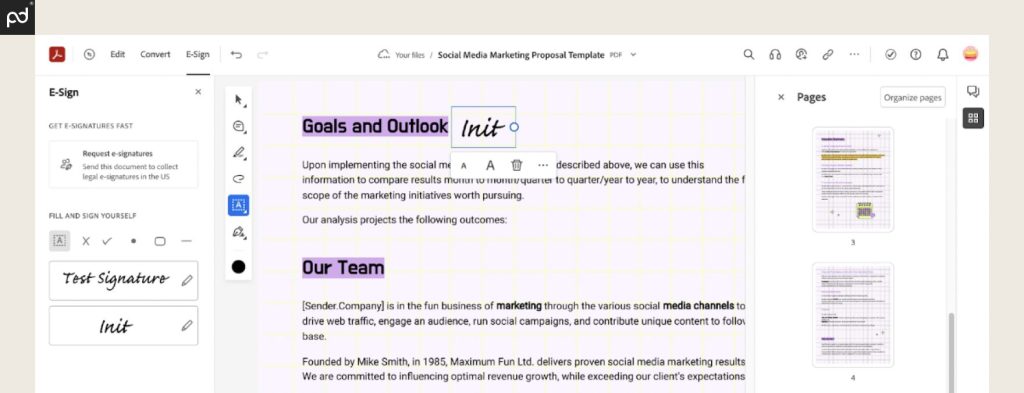
05. Adobe Sign
Acrobat Sign is Adobe’s answer to modern, digital e-signing.
This platform is deeply integrated with the Adobe ecosystem, and users will be able to take advantage of cloud-based services and other Adobe applications (Adobe Reader) as part of their signing process.
This platform is well-suited to businesses who already use Adobe products and for companies who might need enterprise scalability for their e-signing process.
Small businesses may also benefit from Acrobat Sign’s single-user plans.
| Pros | Cons |
|---|---|
| + Built-in PDF editing (except for enterprise plan). | – Varying security for e-signatures. |
| + Works seamlessly with Adobe Reader. | – Transaction limits cap can incur extra fees. |
| + Scalable solution for teams. | – Integrations require enterprise plan. |
The key difference between Adobe and many other signing platforms is the ability to natively edit PDFs.
This isn’t unique to Adobe, since other apps (Foxit) offer similar functionality, but it’s included in all Acrobat Sign plans except the enterprise plan (more on this below).
With other platforms, like signNow, you’d need to purchase a PDF editor separately in order to achieve the same functionality.
Teams who need to edit documents (contracts, proposals, etc.) on the fly will find these features especially useful, as documents can be edited inside the app and won’t need to be pulled back to a word processor for modification when changes need to be made.
That, combined with the ability to leverage templates and customizable signing workflows make Adobe a great fit for many users.
PDF power — with caveats
Without a doubt, PDF editing capabilities are the platform’s standout feature.
While it’s not possible to create a document entirely from scratch, Adobe’s editing tools can help to smooth out frustrations during document preparation.
The e-signing workflows are straightforward and easy to grasp, even for non-technical users, and the entire process can be scaled to fit business operations of any size.
Oddly, everything described above only applies to non-enterprise plans.
Enterprise users won’t receive PDF editing capabilities by default.
Instead, these core features are only available as an add-on, and additional pricing must be arranged by speaking with the sales team.
Fees, caps & limitations
Although powerful, working with Adobe comes with a few important caveats.
Similar to DocuSign, Acrobat Sign caps usage to 150 transactions per user/year.
High-volume senders will have a little more flexibility when compared to DocuSign (100 envelopes per user/year), but it’s still a ceiling that could incur extra costs due to overages.
Adobe’s level of security and compliance are also unclear.
The company plainly states that e-signature captured using Acrobat Standard and Acrobat Pro — the lower-end signing solutions — do not offer the same level of compliance as Acrobat Sign (enterprise).
Although some compliance options require higher-end plans on other platforms, some of the security certifications and industry compliance standards that are common elsewhere seem to be exclusive to Adobe’s enterprise package.
Lastly, Adobe’s integration options are more limited than competitors and are largely restricted to its enterprise offering.
Using DocuSign, PandaDoc, or another competitor, it may be easier to integrate with your tech stack.
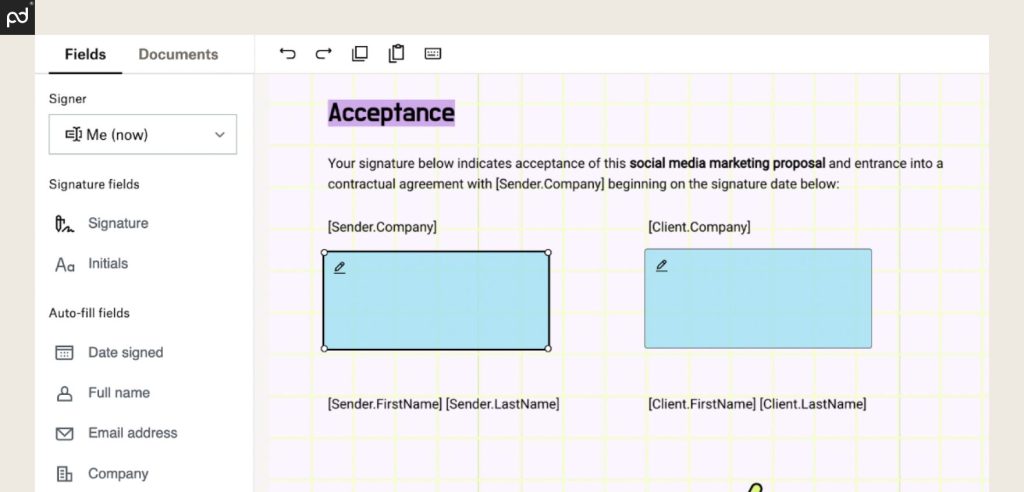
06. Dropbox Sign (formerly HelloSign)
Dropbox Sign (formerly HelloSign) is Dropbox’s separate-but-connected e-signing solution for digital documents stored in the Dropbox ecosystem.
It’s easy to use, with an emphasis on security compliance and scalability.
This platform is good to use if you’re already part of the Dropbox ecosystem, but the product offering is a little tricky to understand due to the options on offer.
| Pros | Cons |
|---|---|
| + No transaction limits. | – Limited templates. |
| + Great security compliance. | – Limited integration tools. |
| + Scalable configurations. | – Confusing plan options. |
As an e-signing platform, Dropbox Sign gives you everything you need to send documents with ease.
This platform features a drag-and-drop interface that you can use to prepare and send documents in real time.
The signing experience is optimized for mobile devices and comes equipped with everything you might need, including audit trails, notifications, link sharing, and more.
However, things get confusing around Dropbox’s plan configurations:
- Dropbox — the storage platform — offers a storage solution which also features e-signing for documents.
- Dropbox Sign — the dedicated e-signing tool — provides an e-signing solution with team controls but no storage.
While our primary focus is on Dropbox Sign, the e-signing and storage options available through Dropbox are a good fit for businesses who might need cloud-based storage for documents and digital assets.
No-limit, simple sending
Dropbox Sign prioritizes simplicity throughout the document preparation and signing process.
While its feature set is less expansive than competitors like PandaDoc or Adobe Sign, which feature onboard editing tools, the platform’s streamlined approach makes for a more intuitive experience that e-signing veterans will find familiar.
Much of Dropbox Sign’s magic happens in the background.
This platform offers a high level of security compliance and maintains certifications for SOC 2 Type II, ISO 27001, eIDAS, GDPR, and others.
Premium plans also offer Electronic ID (eID), which can be used to comply with Qualified Electronic Signature requirements set forth in the eIDAS regulation.
Lastly, Dropbox Sign has no transaction limits, so users can send and sign as many documents as needed with no penalty, caps or extra fees.
Restrictions & limitations
The downsides to Dropbox Sign are largely centered around its template restrictions and seating requirements.
Unlike DocuSign or PandaDoc, Dropbox Sign caps the number of templates that teams can create (5 for Essentials; 15 for Standard) until upgrading to the Premium plan.
This restriction is per plan, not per user.
You’ll also find seat requirements for Dropbox Sign when moving to the Standard plan (two seats required) and Premium plan (five seats required).
This requirement can make Dropbox Sign’s true costs somewhat deceptive at first glance because the list price for the higher-tier displays the cost per seat, not per plan.
The actual price is either two or five times higher than displayed, depending on your plan selection.
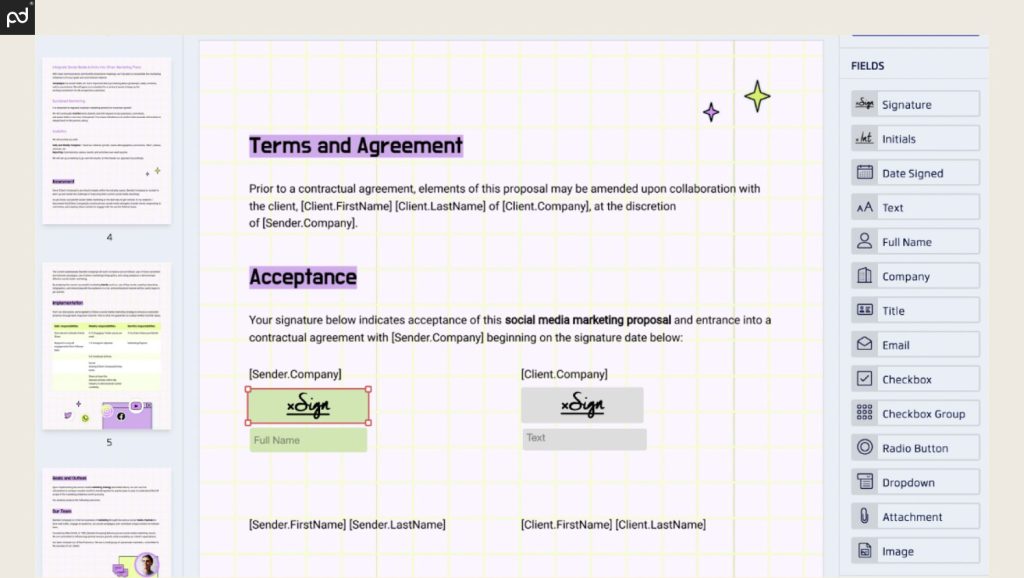
07. Xodo Sign
Xodo Sign, formerly known as eversign, is the latest addition to the Xodo Family of products (along with Xodo PDF and Xodo Drive).
This solution offers straightforward e-signing options and multi-seat solutions at a relatively low cost.
This platform is a great fit for teams who want to keep overhead costs low and don’t mind a no-frills signing solution.
| Pros | Cons |
|---|---|
| + Focused on simple, streamlined e-signatures. | – Lacks advanced signing features as a standalone product. |
| + Seat limits help to offset costs. | – May not be suitable for complex workflows. |
| + Offers simultaneous branding solutions form multiple entities | – Limited integration options. |
Currently, Xodo Sign takes a unique place in the e-signing market.
This platform is related to Xodo PDF, which has its own host of PDF editing and e-signing tools.
However, Xodo Sign does not integrate with or interact with other Xodo products at all.
It’s entirely separate, and teams would need to pay extra costs in order to take advantage of those other platforms.
That’s important, because Xodo Sign is quite limited on its own.
While this platform offers secure e-signing options, many of the advanced features found on other plans (payment gateways, mobile apps, collaboration tools, etc.) aren’t available on this platform.
Before signing up, take the time to consider what functionality you need for your e-signing workflow.
If you require more than a barebones solution, Xodo Sign may not be a good fit.
Plans for teams & multiple brands
One of the best features in the Xodo Sign lineup has nothing to do with e-signing.
This platform provides multiple user seats at extremely low costs when compared to other platforms.
Most platforms issue plans on a per-seat basis. For example, DocuSign’s Business Pro plan is $40 per user/seat on an annual subscription.
If you have five users, you’re paying $200 per month for the service.
Xodo Sign users taking the Professional plan will get five seats automatically for $40 (billed annually).
That’s a much lower monthly cost for secure e-signing when compared to most major players.
DocuSign (compared above) is five times more expensive for the same headcount.
Similar to PandaDoc and other platforms, Xodo Sign offers branding solutions.
However, this platform offers branding options for multiple organizations.
Put another way: If you ran two businesses, Xodo Sign would allow users to switch branding between those organizations and collect e-signatures for both brands.
This is something that most platforms don’t offer.
Those that do, like DocuSign, typically require an enterprise-level plan before this functionality becomes available.
Lacking advanced features
Unfortunately, Xodo Sign lacks the key features necessary to make it a serious player in the e-signing space.
While the platform offers signatures protected by 256-bit encryption and audit trails as part of its activity record, the platform doesn’t appear to align with data compliance standards (SOC 2, Type II; ISO 27001; etc.) upheld by other platforms.
Past the basics, you might also find the platform lacking.
Xodo Sign’s integration library primarily features storage integrations like Dropbox or OneDrive, allowing for easy document import.
However, these storage solutions are common across most platforms, and they lack the functionality required to integrate Xodo Sign with the remainder of your tech stack.
If you need to do that, your only option is Zapier, as Xodo Sign offers no native integrations.
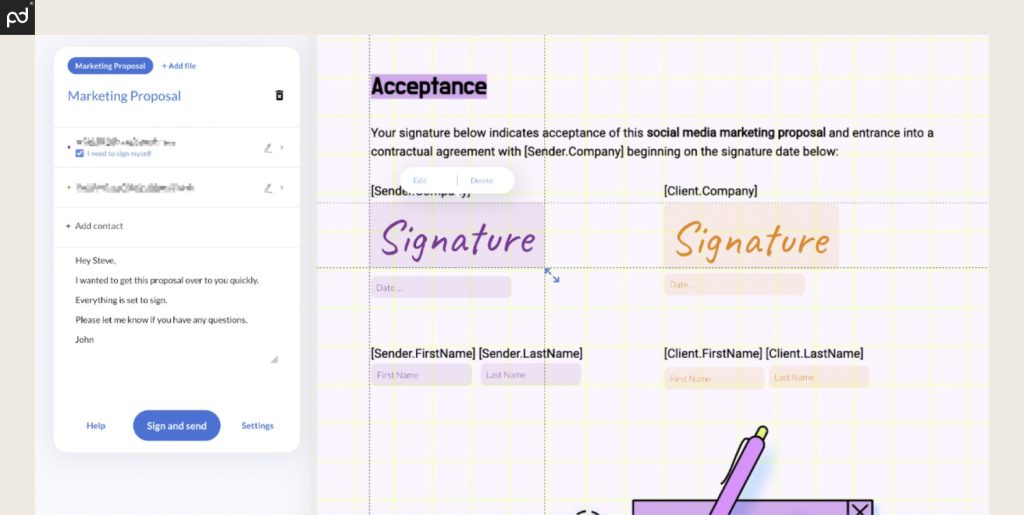
08. SignRequest
One of the most powerful and cost-effective solutions on the market today, SignRequest is a Europe-centric e-signing tool that packs as much as possible into its minimalist workflow.
This is a great solution for solo entrepreneurs, small organizations, and teams who need e-signing solutions but handle most of their document prep and organization elsewhere.
| Pros | Cons |
|---|---|
| + Powerful e-signing features. | – Very simple UI. |
| + Extremely low costs. | – Limited document management. |
| + Good fit for both European and US markets. | – Limited integration options. |
This platform offers a straightforward, no-frills signature tool that feels robust when compared to many other platforms.
SignRequest has streamlined their signing process to a bare minimum.
Users will cover the same information captured in a traditional e-signing workflow, but they’ll do it and prepare the document all in one place.
When the signing is done, documents will be stored in your account, where they can be retrieved with just a few clicks.
Great power; low costs
There is a lot to love about SignRequest, but cost is near the top of the list.
Pound for pound, the platform offers a remarkable collection of features for cost.
Users on the entry-level plan will have access to basic integrations, custom branding, the ability to send and receive attachments, bundled documents, and more.
Some features, such as text message verification, are withheld by competitors as part of higher-tier solutions.
SignRequest users on the Business plan have access to all the features on the entry-level plan, as well as premium (limited) integrations, including Zapier and a handful of obscure platforms.
Almost too simple
In review, we found SignRequest’s workflow almost too simple.
You’ll begin the signing process by filling out the recipient details (email, name, etc.) and uploading the document.
However, upon upload, the document appears on the right-hand side of your screen while the informational window floats on the left.
All the information you need to send your document, including the accompanying email, is located on a single screen.
In theory, this sounds very efficient. However, in practice, this is a ton of information located all in one place.
We found that this approach splits the focus between document preparation, signer prep, and final confirmations before sending the document.
The other big downsides with SignRequest relate to integrations and document management.
This platform is exceptionally powerful — particularly for its low cost — but its lack of robust integrations make it a hassle if you’re trying to connect it to the rest of your tech stack.
For reference, SignRequest offers a total of nine integrations, and some are linked to niche software (M-Files, JuriDoc, B-ware, etc.)
By contrast, PandaDoc offers around 40 native integrations, including connections to popular CRMs, storage, and productivity tools.
When it comes to file management, SignRequest has a limited interface, but it’s nothing as robust as you’ll find in PandaDoc or a dedicated document platform like Sharefile or DocSend.
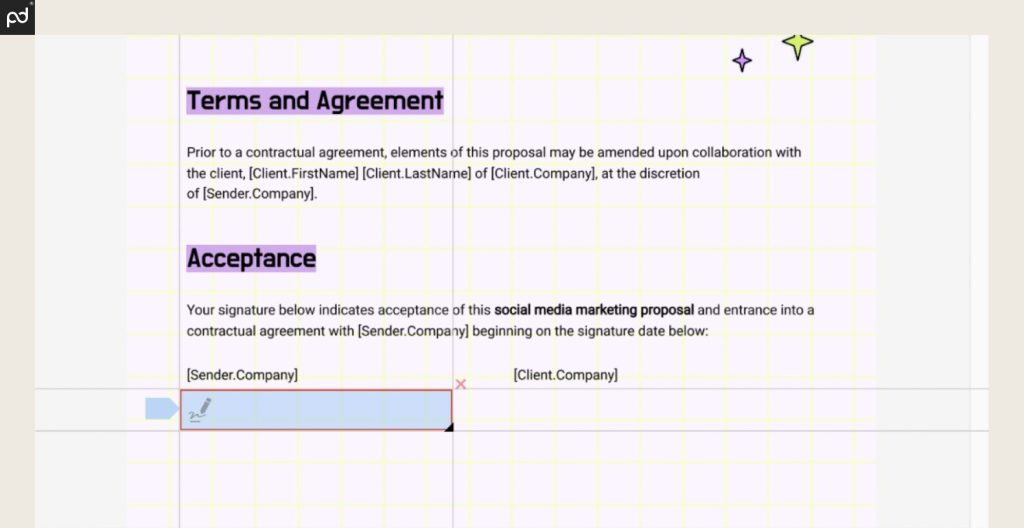
09. Foxit eSign
One of the oldest players in the e-signing space, Foxit Software has been around since 2001 as a developer of PDF software products.
This toolkit is ideal for teams who want PDF editing and e-signing tools that work seamlessly together, either through online or desktop modes.
| Pros | Cons |
|---|---|
| + Intuitive interface. | – Limited security compliance. |
| + Access to Foxit PDF editor. | – Limited integrations. |
| + 24/7 customer support. | – Hard transaction cap. |
Strictly from the perspective of e-signing, Foxit’s e-signature capture process follows a similar workflow to what you’ll find with most other platforms.
Users will convert uploaded documents to PDF, prepare them for signing, define roles, and send documents for e-signing.
This entire process can be branded using colors and logos, and the workflow can be further simplified with reusable templates.
Once signed, documents are stored in Foxit’s onboard cloud storage, and signed copies are sent to both the requester and the signer.
Signatures with PDF support
Foxit is a unique entry on our list because the e-signing platform is released in conjunction with its PDF editor (similar to Adobe Acrobat Sign).
By signing up for Foxit eSign, users will gain access to tools that allow for effortless PDF editing and customization.
While you won’t be able to create documents entirely from scratch, you can modify and customize PDFs as if they were native, unlocked documents.
This functionality is rare, and only a few platforms outside of Adobe Acrobat Sign offer it as part of their e-signing package.
On top of that, Foxit is one of the few companies other than PandaDoc that offers 24/7 chat support as part of any plan, so you’ll always have access to help when you need it.
That’s a huge advantage over companies like DocuSign, which only offers email support with long wait times unless you pay for upgraded support options.
Hard caps & limited compliance
The downsides to Foxit eSign center around its hard transaction limits and regulatory compliance.
While the company maintains compliance with all regulatory standards (eIDAS, ESIGN, UETA, FINRA, CCPA, FERPA, GDPR), SOC 2 Type II compliance protocols that are standardized with DocuSign and PandaDoc are only maintained for data on enterprise-level plans.
If how your provider handles sensitive information is important to your documents, this lack of compliance on lower plans may factor in your purchasing decisions.
Additionally, all Foxit plans have a hard transaction limit.
The eSign plan caps document sends at 250/year while the eSign Pro plan offers a 500/year transaction limit.
These are hard caps, meaning that the software will simply stop working when the transaction limit is reached.
Although users purchase an annual plan, teams who reach the transaction limit prior to the year will need to renew their license to continue usage.
In many ways, this approach is more restrictive than the soft cap applied by DocuSign and others, where costs may increase but the software will continue to function while you negotiate rates with the platform sales team.
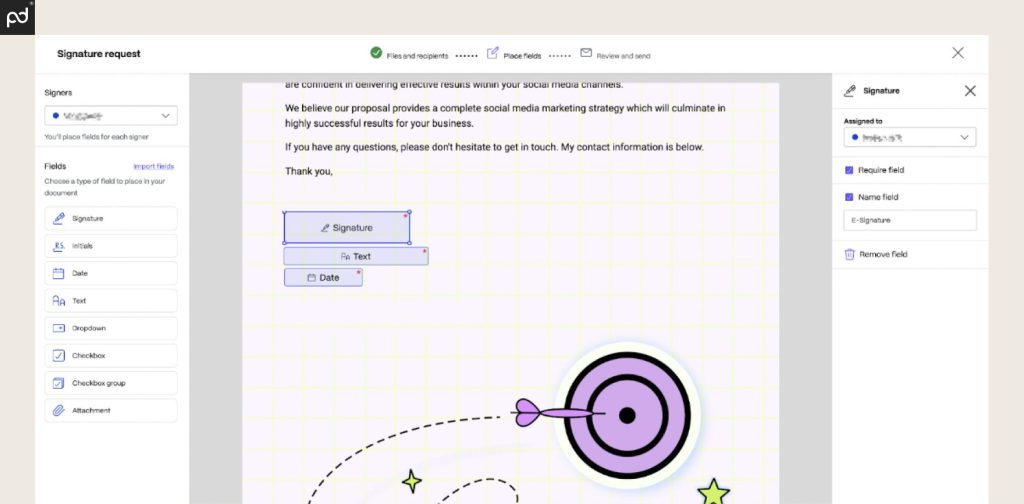
10. Sharefile Premium
One of the plans on the Sharefile platform, Sharefile Premium combines document storage and sharing with a suite of e-signing tools from Citrix RightSignature, which was recently consolidated into Sharefile.
This platform is a great fit for teams who need onboard storage solutions (similar to Dropbox) and want to combine that with their e-signing protocols.
However, due to the high price of this plan, this won’t be a viable option for individuals or very small organizations.
| Pros | Cons |
|---|---|
| + Combines storage and signing functionality. | – Minimum seat requirements. |
| + Great access control options. | – High initial costs. |
| + Unlimited signature capture. | – Confusing platform features. |
As an e-signing platform, Sharefile Premium follows the standard process seen in most other digital signature workflows.
Users will upload documents, assign recipients, prepare documents using drag-and-drop tools, and send documents to signers directly from the Sharefile platform.
The process is fairly straightforward and well-structured, as this functionality was previously a separate, standalone product (RightSignature).
One key difference is that you’ll be able to import documents or utilize files already within Sharefile to facilitate the digital signature process.
Security meets e-signing
Among other e-signing platforms, Sharefile is unique because of its file sharing and document management capabilities.
The Sharefile platform is designed to help organizations share and collaborate with customers and external partners without the need to sacrifice security.
The system is designed around limiting informational access and data control, which gives users on the platform plenty of options when sharing sensitive information with clients.
You won’t find anything quite like it outside of Dropbox’s DocSend (discussed below).
Because the platform is built around handling sensitive and private information, the e-signing functionality included in Sharefile feels like a natural extension of that process.
Teams can work together inside Sharefile to reach tentative agreements before loading relevant contracts, documents, and data into the e-signing tool to finalize the deal.
However, because these e-signing tools were originally part of RightSignature, the e-signing workflow is largely separate from file storage.
While you won’t have to leave Sharefile to access it, the module is entirely different from Sharefile workspaces, so e-signing won’t happen directly inside your shared client workspace.
Costs, seating & platform confusion
Because Sharefile requires a three-seat minimum, its onboarding costs feel prohibitively high when compared to competitors who offer single seat plans.
If teams can provide three users for the platform, the cost per head is roughly $27.50 per month.
Considering the storage and security aspects of Sharefile, that’s not a bad deal if your team needs that toolkit.
For single users, however, the entry-level costs will outstrip other alternatives.
The other major drawback with this platform is the ongoing integration between Sharefile and RightSignature.
Although Citrix consolidated RightSignature into Sharefile in late 2023, the software still feels completely separate from the rest of the platform.
What’s more: Only Sharefile Premium users have access to e-signing tools.
Enterprise-level users on the more expensive Virtual Data Room plan don’t get these features.
If considering Sharefile, be sure to approach your plan selection with care.

11. DocSend
Another Dropbox product, DocSend is an e-signature platform with a strong emphasis on document analytics and file sharing via virtual data rooms.
This platform is a good fit for businesses who want a more interactive e-signing experience.
Signers can be invited to rooms, prompted to review key documents, and then sign all documentation when ready.
DocSend’s analytics and tracking will monitor engagement and report those details back to the user.
| Pros | Cons |
|---|---|
| + Powerful document analytics. | – Key feature integrations. |
| + Secure data rooms. | – Notable gap in plan pricing. |
| + Great support options. | – Limited integrations. |
Compared to the other platforms on our list, DocSend aims to differentiate itself by heavily emphasizing its data rooms and granular document access control.
Despite its focus on these tools, it contains a similar e-signing experience offered by most other platforms.
Signers will upload a document, add signers, prepare the document within a drag-and-drop interface, and then invite users to interact and sign files in a secure space.
Data rooms & informational control
DocSend’s approach emphasizes granular document controls and analytics.
Users always know what happens inside the rooms, and usage insights are reported so that teams can improve the experience for next time.
This is similar to what users experience with PandaDoc analytics, but at a larger scale.
DocSend tracks everything from where documents are accessed to what was exported, who watched videos, and whether or not documents were forwarded to other senders.
Essentially, the entire experience is tracked and summarized for users.
The arrow in DocSend’s quiver is the ability to control information at a granular level.
Particularly on higher-end plans, documents can be restricted or watermarked.
The ability to view documents can even be tailored to specific links, meaning that multiple people sharing the same room may not have access to the same collection of documents.
For fans of document management and access, DocSend’s features will resonate like few others on our list.
A niche approach to e-signing
While DocSend has some great features to offer, it’s also in a strange place, competitively speaking.
Due to the platform’s heavy emphasis on document control, e-signing feels like more of a consequence than the entire point of the exercise, which places this platform at odds with key competitors like Sharefile (above), GetAccept (below), and PandaDoc.
All of these competitors have virtual deal rooms and negotiation spaces, but each one is built around a mix of customer collaboration and access control.
Interestingly, the DocSend experience isn’t interactive. It’s purely about file management and data control.
The other key shortfall is the platform’s lack of storage.
Each user is limited to 50 gigabytes of platform storage, and data rooms are limited to 2,000 assets.
Those are excellent numbers, but Sharefile offers unlimited storage, client portals, granular access control and more at a considerably lower cost when compared to DocSend Advanced and Advanced Data Room plans.
Because of this, DocSend’s place in the modern e-signing market is so niche that users may want to consider other competitors who offer very similar features.
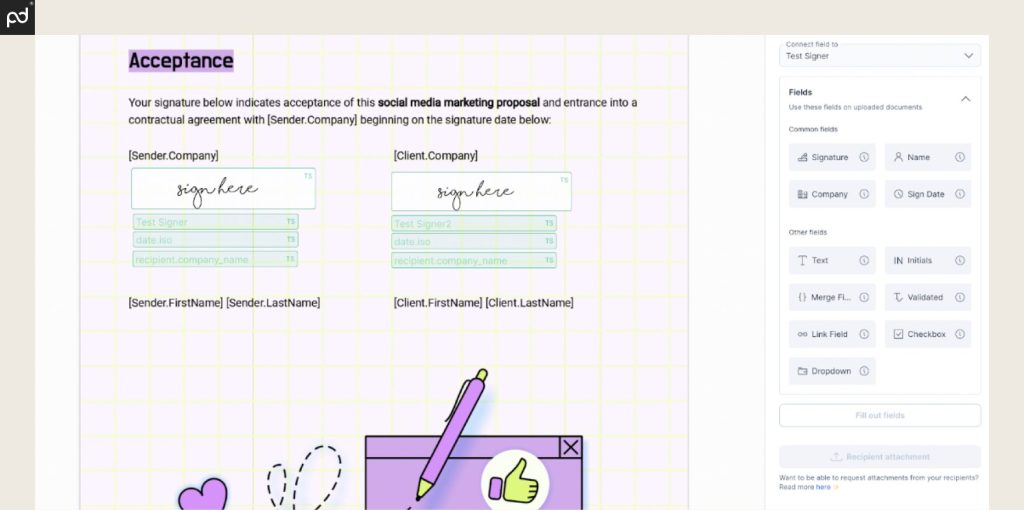
12. GetAccept
A sales-focused platform, GetAccept combines e-signatures, document creation, and workflow automation to improve customer engagement and increase sales efficiency.
This platform is a good fit for sales teams who want to consolidate their selling process into a single platform where engagement can be tracked and used to push deals to close.
| Pros | Cons |
|---|---|
| + Sales enablement focus. | – Integrations are add-ons. |
| + Onboard document creation. | – Document creation is clunky. |
| + Great integration options. | – Confusing pricing options. |
GetAccept offers a kitchen sink of features to help users succeed.
This platform can handle everything from document creation and e-signing preparation to collaborative live chat and analytics capture.
Teams can integrate their CRM data with GetAccept to further accelerate the sales process, and then continue working within the platform for the full lifecycle of the deal.
While this platform lacks components of revenue generation and outreach when compared to an enablement platform like Gong or Salesloft, it definitely aims to straddle the line as an e-signing / document creation tool and a sales platform for deals already in progress.
The complete package
GetAccept gives you everything you need for document-based selling.
Users will have access to onboard document creation tools (similar to the PandaDoc editor), virtual deal rooms, a product library, sales dashboards, and much more.
All of these features are centered around sales enablement and lead cultivation.
While the platform won’t help you find leads (one of the few things it doesn’t do), it’s designed to give your team all the tools you need to convert leads to sales with documentation, specialized deal rooms, and much more.
As you might guess, e-signing only plays a small role in this process.
Much of GetAccept’s attention is focused on buyer-seller collaboration, automation, and deal velocity.
Downsides & costs
While GetAccept offers a huge selection of tools to get deals off the ground, many of these features feel unrefined and clunky on use.
For example, it’s possible to create documents from scratch in the GetAccept editor, but this tool feels cumbersome when compared to PandaDoc and Proposify, where document editing is a core part of the experience.
The other key issue we see is with pricing and cost.
GetAccept offers a total of seven pricing plans, and the plan you buy doesn’t include the add-ons you’ll need for many automations and CRM integrations.
You’ll likely need to speak with a specialist to truly understand the final costs, add-ons and specific packages included.
On balance, the total cost may be considerably higher than expected.
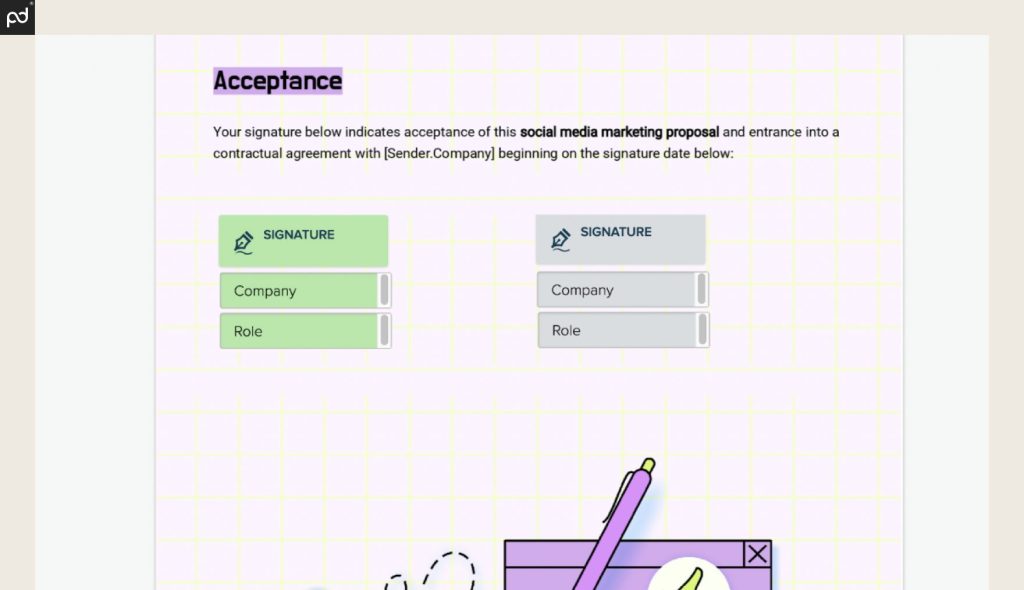
13. Proposify
Proposify is a proposal-based platform that combines powerful document creation tools, e-signatures, and document analytics.
It’s a great fit for businesses who rely on customized quotes and proposals as part of their sales process or who want detailed insights into how clients interact with their documents.
| Pros | Cons |
|---|---|
| + Powerful document editor. | – Lacks forms, product catalogs, and other common tools. |
| + Template / automation tools. | – Templates can become very complex. |
| + Powerful integration options. | – Difficult upload process for existing proposal templates. |
Compared to other e-signing tools on our list, Proposify tries to strike a balance between offering more than e-signing but not so much that it loses its niche or specialization.
Without a doubt, Proposify is a proposal designer first and an e-signature tool second.
The entire onboard workflow is built around document creation and proposal design, with the majority of tools and features angling toward that purpose.
E-signing fits comfortably into this design flow as the natural “last step” when creating the document.
Users will leverage the same drag-and-drop interface used to design the rest of the proposal in order to add and assign signature fields for signers.
Because Proposify’s documents can be created as a template, these signature blocks can be left blank and assigned when the proposal needs to be generated and as part of a personalized proposal package.
Proposals made easy
If your business generates a high volume of sales proposals and needs a system to help you produce on-brand documents, Proposify is one great answer. (The other is PandaDoc!)
Designers and graphically inclined team members will love working within the Proposify editor.
The platform offers great control over styling, fonts, and formats.
Multimedia can be embedded seamlessly, and the block-style interface makes it easy to build complex documents with ease.
You’ll also find several tools to move the proposal farther down the pipeline.
Setting up a review process is effortless.
Connecting Proposify to your CRM allows via integrations you to plug in customer data through variables to avoid adding typos and incorrect details.
On top of that, documents can be built as empty templates, allowing users to add relevant data when it’s time to personalize a proposal for a specific customer or deal.
Most other e-signing tools force document creation to third-party or offline tools.
Currently, the PandaDoc editor is the only other editor on our list that offers a similar experience.
Limited toolkit
While Proposify is fantastic for proposal creation, it falls short when offering tools to facilitate other aspects of a sales process or deals flow.
For example, PandaDoc can assist with contract creation, function as a form builder, or help users generate other pieces of essential deal collateral.
Sharefile and DocSend offer dedicated client spaces and robust analytics for all intractable documents (not just proposals).
Acrobat Sign and Foxit offer PDF editing tools alongside e-signing.
Additionally, Proposify templates can become very complex — to the point that the company offers software training and professional (paid) services to assist with template design.
These services come with a high price tag ($3,000).
Placed in perspective, that’s enough to pay for a team of five members on the PandaDoc Business plan for a full year!
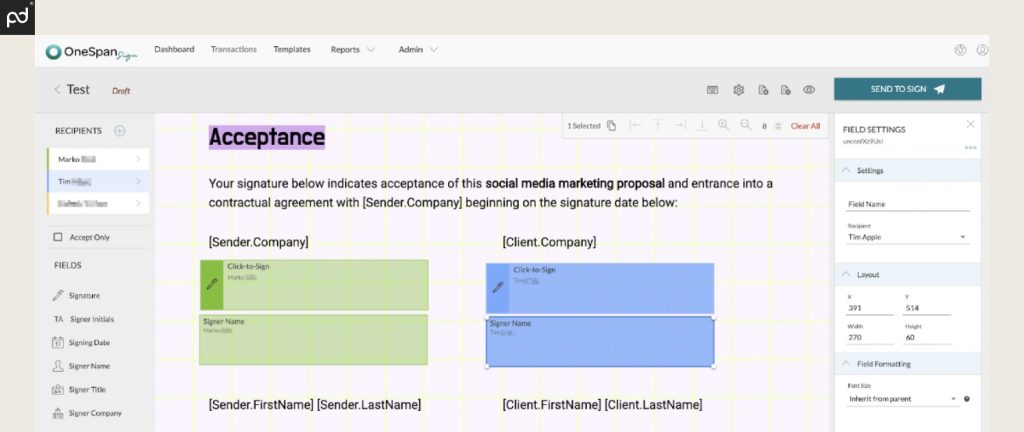
14. OneSpan Sign
Focused on security and compliance, OneSpan Sign offers e-signing solutions that will appeal to users in heavily regulated industries.
This e-signing platform is a great fit for teams who require security features that go above and beyond the standard protocols seen in popular e-signing platforms.
| Pros | Cons |
|---|---|
| + Robust security and compliance. | – Limited integration options. |
| + Detailed audit trails. | – No supplemental features. |
| + White-labeling options. |
As an e-signing platform, OneSpan Sign’s key strength is its security focus.
However, unlike many other platforms on our list, OneSpan Sign is only an e-signing solution.
It doesn’t offer storage options, document creation tools, or other supplemental features.
Instead, this platform provides an easy-to-use, drag-and-drop interface that allows to prepare documents and send them for signature capture.
It’s a straightforward, no-frills solution without a steep learning curve.
Secure, white-labeled e-signing
While DocuSign, PandaDoc, and most other e-signing platforms offer robust security options, OneSpan Sign focuses on aspects surrounding user identity, authentication, and validation.
The platform offers additional layers of security which go far beyond the norm, including biometric comparisons, validation via government IDs, smart card authentication, and more.
Many of these features simply aren’t available on other platforms.
Similarly, OneSpan Sign allows its product to be completely white labeled.
Most platforms will allow for some branding options, but only OneSpan removes all traces of its corporate identity, allowing users to reconfigure the branding to suit their own purposes.
Narrow use case
While most companies value security, OneSpan Sign will offer too much for most users.
Without a specific use case, the niche security and compliance functionality baked into this software will far exceed signer requirements.
For most users, the security features set forth by major industry brands will be more than enough to validate signers and keep sensitive information safe.
With that in mind, users outside of specific fields may be better served with a standardized signing solution or a platform that combines e-signature capture with other features (storage, document design, etc.).
Before wrapping up, it’s worth taking the time to figure out what solution makes the most sense for your business.
Here are a few questions to consider when evaluating electronic signing apps.
What role is your e-signing solution intended to fill?
Traditional e-signing solutions — like DocuSign or SignEasy — specialize exclusively in digital signature capture.
Users will upload finished documents, prepare them for e-signing via a drag-and-drop interface, and dispatch them to recipients using the platform’s onboard sending tools.
However, in an effort to differentiate themselves from market leaders, several platforms offer additional features alongside their e-signing solution that may provide a more holistic user experience.
Depending on your business needs, a traditional solution may be a great fit.
If you have additional or outstanding needs surrounding file management, document creation, or sales flow, choosing the right platform to assist with online document signing may help you overcome other operational challenges.
How many users will you need?
Most (not all!) electronic signature apps license platform usage by single user or seat.
Because of this, the number of users will have a significant impact on platform costs.
Some platforms, like Dropbox Sign and Sharefile Premium also have user/seat minimums for their plans.
This means that you’ll get a minimum number of seats as part of the plan, whether you use them or not.
For small businesses, multi-seat minimums may not be a good fit, especially if only one user is required to facilitate document signing.
However, teams that have the necessary headcount to utilize every seat will often find that multi-seat plans provide premium features at lower per-seat costs than competitors offering only single-seat plans.
For example, Sharefile Premium offers e-signing and powerful document management tools for $82.50/month, with a three-seat minimum. That’s $27.50 per user/month.
By comparison, DocuSign’s Business Pro premium plan is $40 per user/month when billed annually.
In this scenario, companies who need three seats (and who can take advantage of Sharefile’s unique feature set) would come out ahead with Sharefile.
How many documents will each user need to send?
Several e-signing platforms restrict usage via “envelopes” or transaction limits.
- DocuSign caps usage at 100 sends/year and 10 sends/month.
- Foxit eSign caps usage at 500 sends per year/license.
- Acrobat Sign caps usage at 150 sends/year.
- SignNow caps usage at 100 send/year.
These limitations vary from platform to platform, but the end result is the same: If usage is capped, exceeding the designated sending limits will incur additional fees.
You’ll also find several platforms that don’t restrict usage at all.
PandaDoc, Dropbox Sign, SignRequest and a few others allow users to sign documents online without worrying about overages.
Some platforms also try to find a middle ground between these two extremes by capping usage based on “fair use.”
In these cases, exact usage restrictions (and the penalties for overages) are largely undefined.
Before onboarding with a document signing app, take a minute to calculate how many documents users are likely to send in a year.
Certain departments (sales, HR, legal) may need higher send volumes due to the nature of their operations.
Does your e-signing solution need to integrate with your tech stack?
Most e-signing solutions offer integration options, which enables the platform to talk more effectively with CRMs, ERPs, payment software, and other technologies.
Depending on your business needs, integrating your e-signing platform with these tools can streamline workflows and boost team productivity.
In general, larger e-signing platforms offer more integrations.
Smaller platforms sometimes offer connections via Zapier as an alternative solution, but this will require an additional subscription with Zapier to enable functionality.
With most platforms, you’ll also find that integrations are locked behind premium- or enterprise-level pricing plans.
If these features are a requirement, be prepared to pay more for that connectivity.
Does your industry require specialized security or compliance?
While most e-signing tools provide standardized security compliance, take the time to consider your unique signing needs and whether the solutions on offer can meet that demand.
DocuSign, PandaDoc, and many other apps are SOC 2 Type II certified and GDPR compliant.
Some solutions include HIPAA compliance or data residency, but these features are often restricted to higher-tier plans.
Europe’s eIDAS Regulation is a hurdle for many e-signing tools, which divides e-signatures into three separate categories (further reading here).
Most platforms will provide advanced electronic signature (AdES) solutions.
If you need qualified electronic signatures (QES), you may need to work with very specific providers — like DocuSign, YouSign, signNow (limited) and others — who are considered Trust Service Providers on the EU’s Trade List.
You can search by provider name using this tool.
Regarding security, OneSpan Sign is a cut above the rest.
The entire platform is built around user identity and security, offering biometric comparison, government ID verifications, and other multi-factor authentication tools that are largely overlooked by most other e-signing platforms.
Take a few minutes to determine the level of security and compliance your documentation requires.
Knowing this up front can drastically narrow your search options.
What is the best electronic signature software?
While there are an abundance of e-signing solutions available on the market, the best solution will be the one most suited to your needs and budget.
However, all things considered, PandaDoc offers a broad toolkit to help you succeed.
From e-signing and document creation to team management and user collaboration, PandaDoc users can handle every aspect of their document process without ever leaving the platform.
Want to give it a try?
Sign up for a personalized demo, or try everything for yourself with a 14-day trial.
Disclaimer
PandaDoc is not a law firm, or a substitute for an attorney or law firm. This page is not intended to and does not provide legal advice. Should you have legal questions on the validity of e-signatures or digital signatures and the enforceability thereof, please consult with an attorney or law firm. Use of PandaDocs services are governed by our Terms of Use and Privacy Policy.
Originally published February 21, 2021, updated June 26, 2024

